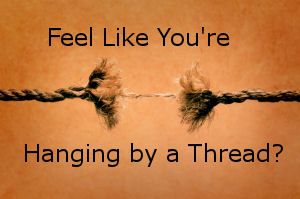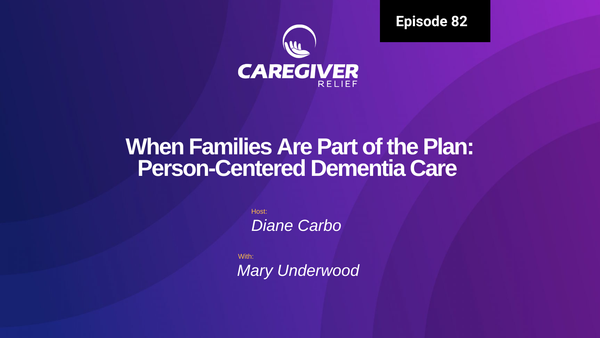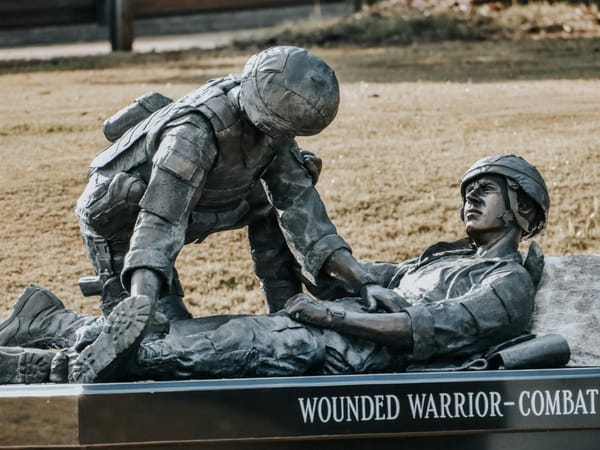When Death is Imminent with Pat Deegan RN MA - Episode 16

Welcome to Episode 16 of our podcast, "When Death is Imminent." Dying is a natural process that occurs in stages. It can take minutes or months, depending on the individual. Today, we're going to delve into the physical signs of dying to help you better understand what happens during this profound transition.
Diane Carbo: Hi, this is Diane carbo with Caregiver Relief. And today I have with me, our end of life specialist, Pat Deegan. She is also a regular podcast contributor. And today we are going to talk about the stages of death and dying.
Diane Carbo: And when death is imminent, pat, you and I are both seasoned nurses, probably have over a hundred years of experience between the two of us we’ve been at the bedside of many patients that have died before we start the talk I have to share a story with you in the listeners.
Diane Carbo: That happened to me over the weekend. And it’s just a commentary on where we are. In our culture. I am I dog sit for friends I have two dogs that I’m sitting for. DECA has been on seizure medicines for awhile. While I was here he had three grand mal seizures on Saturday. Now he’s a big guy. He’s 150 pound baby. What seems to be an interminable amount of time when somebody goes into a seizure, whether it’s a person or dog, you just go automatically into how long.
Diane Carbo: Going to be anyway, they were 90 seconds. He had the first one and I thought, okay, he’s having a breakthrough through his medicine. Anyway, long story short, he had a second one within an hour. So I was challenged, but I got him into my car and I took him to the ER. Now here’s the surprising thing that happened while I’m in the parking lot, filling out the paperwork because of COVID they don’t want to end poor Beckam is in my back seat having a third seizure.
Diane Carbo: So I yell out to them to that he’s having a third seizure that I just wanted them to observe it to the thing knew what was going on. , as they give me the paperwork to fill out the question that they asked me brought not only tears to my eyes, but was a shock. If he stops breathing or his heart stops, you want CPR on this animal, on your pet.
Diane Carbo: You know what pat I was in shock. I really was. My first response was, oh my God, please don’t let him die. Of course he’s not my dog. So I said, yes, absolutely. You must do everything that possibly can be done for him. After I said that. I started asking questions because the nurse in me kicks in, we are trained to be not the emotional, but the logical
Diane Carbo: so the next step is , I said to them, as they were carrying him into the office, I said, What what does CPR entail for a dog? I said, will you break his ribs? Will he need to be ventilated? , what do you do for him? And if his brain is so bad that he’s having all these seizures, which is something that happens to adults humans, as well as animals we’ll we need to make a decision.
Diane Carbo: To have him removed from these, sustaining things. If he doesn’t come back and all those were questions I asked. Then I wanted to know, if he was that bad and his heart stopped or he stopped breathing and they did CPR. What medicines would they be sending him on if they could resuscitate them anyway, long story short we no longer as a culture except death and dying as a natural process, not even for our pets and people do not understand that death is a natural process.
Pat Deegan RN: Yes, it is. What was the outcome? I’m curious to know how was the dog?
Diane Carbo: I am blessed and grateful he didn’t stop breathing and didn’t his heart didn’t stop and they didn’t have to make that decision. Now he’s on some God awful terrible medication, which has left him very unsteady and eating and drinking. Here’s the other point I’m going to make before we get onto our death and dying process conversation is we choose to take medicines. We choose to take treatments. We don’t know the consequences of those decisions and what the side effects are going to be. Whether it be from a seizure medication or chemo or whatever.
Diane Carbo: And sometimes the treatment is worse than The relief of death. I’m just going to say that it’s going to make some people very unhappy, but anyway, . I said it, and I love this pet and God bless him. It’s been challenging. His folks are out of town or out of the country. I have been very challenged in trying to provide care for him.
Diane Carbo: Cause he’s got some terrible side effects, but they’re hoping that he will improve. But anyway, this is what people are going to deal with their pets now, not just with our family members. So it was scarred about death is the dying process. Yes.
Pat Deegan RN: With jokes. Now this is all new. I’m just as surprised as you. How were they going to notice the public? Now, if it’s not like people like yourself or myself to even consider that they have to think about, let’s say a DNR on their animals.
Diane Carbo: You know what, pat, that’s a good question. And I don’t know. I have to tell you that I think that we’re in a culture where it’s seen as a failure, if someone, or even a pet dies and I think that the fear of death is so great that. Oh, people don’t want to accept it. And they don’t understand that the consequences of extending life it’s not quality of life all the time. And it’s just the quantity of time and they don’t understand that it can cause pain and suffering to extend life.
Diane Carbo: So let’s talk about the death and dying. There are stages of dying and you have worked hospice for many years. Let’s discuss what goes on. , first I’d like to start with, our bodies decline. And some of us it’s a slow decline and some of us it’s more rapid decline. And as a death and dying process, according to hospice can take minutes to months. Before we start the active, dying process. I want people to understand that our, the biggest number, one reason that the show that a person is starting a physical decline. And I don’t think many people realize that are detrimental and can often rush a decline.
Diane Carbo: So we have signs that your body is going to shut down in the active stages of dying. So let’s talk about that, pat.
Pat Deegan RN: Okay. Profound things. If we want to say that death comes at its own time and in its own way at via, it really does. Everybody’s different. It’s not a book type thing that this is going to happen on this and now unique to the individual and how they lived and how they express themselves. I’m going to try to go through a scenario is if I were taking care of a patient that was dying. So between one and say three months, maybe Actually probably starts the dying process, although we don’t see it as such and it will bring us up to about two weeks before they are dying.
Pat Deegan RN: The patient becomes extremely withdrawn. He acknowledges internally, oh yeah, I know I’m dying and that kind of thing, but he has no interest like in the newspapers, TV or visiting from, a relative or anything. He’s just closing himself off. I say the process, and this is only because I’ve seen it so many times.
Pat Deegan RN: It will appear that the patient is sleeping all the time or his eyes are closed, but that doesn’t really mean that’s what he is. He is internally going through the process of leaving this world and going into another one. One thing I will say that I’ve noticed time and time again, even though they are withdrawn and seem not to be responsive.
Pat Deegan RN: The idea of touching their hand or touching their face or saying something to them, you will see a shift where they might turn towards you because they’re acknowledging the fact that you’re there. And I don’t think people think of that. They don’t want to be bothered with the, the TV and the drone on and on.
Diane Carbo: And this was very distressful. Yeah. This is very distressful for family members to deal with because they start their anticipatory grieving process, but family members also we’ll talk about this as we go along, but family members want to do something and intervene in some way and it’s not always possible to do that or should you.
Pat Deegan RN: And I think in response to what you’re saying, We as a public thinks that, we have to eat to stay healthy and eat and you’ll feel better. And all this food is probably one of the things that the patient probably doesn’t want at all. And it’ll start gradually oh, the meats too tougher, or I don’t like the taste of it or something.
Pat Deegan RN: So they’ll go to softer foods that are more palatable and then they get to the point where all they want really are like liquids. And I think I told a story last week about my daughter, when my husband was dying, she was so excited that he wanted a Popsicle because she equated that with he’s feeling better.
Pat Deegan RN: This is good for him, but I think we tend to forget. I have a whole, unless you’re in the nursing profession, that when the body’s dying, , all the systems in our body, the kidneys, the lungs, everything, they are also slowing down and they were not capable of the metabolizing of these foods and it can definitely cause a decrease in their pain level. And I don’t, we don’t stop to think of that. Cause we’re just concerned that they got to eat something.
Diane Carbo: You know what? I just had a post on one of the forums that I’m on. A caregiver was so upset because her mother hadn’t eaten in two or three days. Hadn’t had anything to drink and she was just beside herself. That she was going to Sue the facility for neglect for not force-feeding her mom. And then of course, I always hear, , they’re killing my mother or my father. And again, it’s an emotional response, but there’s logic behind what is going on.
Diane Carbo: And that’s what we’re here today is to take the mystery away. Gives you an educated and an understanding of what happens in the death and dying process. So you can understand and not feel so compelled to fight the death and dying process.
Pat Deegan RN: Very good. I think that somewhere between maybe one or two weeks before deaths now, like I said before, everybody’s different. There is a increase in their disorientation. They want to sleep a lot. They can be awake. The more confused., my husband saw his mother. . So they see relatives or people sometimes when they’re dozing and stuff. And this really alarms people because they think, oh my God, what’s happening now. But this happens more often than not that they will be seeing people and talking to them.
Diane Carbo: Exactly. I’ve seen this too, where they become paranoid and aggressive and agitated because at the end and fearful, not for any reason other than they’re having hallucinations.
Pat Deegan RN: At this point, like you said, they might be picking at their clothes or the bed linens, or, they’re very preoccupied. Maybe that’s the way I want to say it. And at this point, if you were a nurse or if you had a nurse come in, their blood pressure changes, the pulse changes, it can go very high and then it can go very low and this is just because there’s just not enough oxygen in the the blood for the heart to pump it to these particular extremities. And this is where you’ll also see some modeling. So we call it or blotchy skin points like on the buttocks and stuff in the legs, especially the nail beds. They’ll get a much different color.
Pat Deegan RN: All these things are happening. All at once, but most people won’t pick up on them until it’s right smack in front of their face. But these are gradual things that are also helping. What’s your also see, I don’t know if the patient had a catheter or if they were just incontinent. You’ll see a change in the color of their urine.
Pat Deegan RN: As it gets closer to time to death will become more concentrated instead of. Pale yellow that we would have, it would maybe get a little bit darker and then turn maybe a little bit orange and then a little bit darker. And that’s just telling you that the kidneys are shutting down and it’s just a matter of maybe a day or two, but that’s just my perspective of seeing it so many times.
Diane Carbo: Yes. Some people can last as long as I’ve had clients and I’m sure you do that have lasted seven to 10 days. It’s just that they’ve retained fluids for so long. I do want to step back a moment and say that. Skin of the feet and hands becomes a purple-ish gray color and blotchy, and that makes people very frightened. But again, it’s due to the decreased, the blood pressure, the decrease in the heart, the way it’s working and functioning and the lack of oxygen to the extremities and that frightens people.
Pat Deegan RN: With their breathing. It might become very congested, they can’t clear their throat, cough it up, but again, this is normal. You might, there’s all kinds of breathing, they’ll breathe for a minute. And then it looks like, oh my gosh, they’re not breathing. Cause we might take a little bit longer than the gas for breath and stuff. And then you know that, death is accordingly just around the corner almost. At some point around this time, the one or two days, so become unresponsive. You cannot arrive with them at any point. And I think, and this is my own observation, how we, or the patient or how they approached them. I think it depends on how they live their life. I’m convinced with that. And how much did they participate in their life and with other people?
Pat Deegan RN: And if they’re willing to let go, and I’ll tell you a funny story about that second and the fear of unfinished business. I know I’ve said this before, and I’m going to say it again and again, if there’s been a fracture in a relationship or something has to be resolved. This is holding them back from, from actually leaving this material world and that can cause a great deal of resistance in actually meeting their death head-on and it usually at this point breathing stops and that’s funny. It’s not funny, but there’s all stopping you. I was like, oh, he’s gone. And then frequently they’ll make, they’ll take a, another one dress and everyone gets excited thinking over there coming back, but it’s not, it’s just the body releasing the rest of the oxygen.
Pat Deegan RN: One of the things when my husband was dying, this is many years ago, so it may not make sense now, but the last couple of days, and I knew it was just a matter of the day or two, he tased me. Pat what’s today’s date. And I would know, oh, today is such a such the next day. Pat what’s today’s date. I might show him again and say, why is he so fixated about what day it is?
Pat Deegan RN: So then on the Thursday he said, what’s today’s date. And I told him, and he died three, three hours later, and I am convinced that he stayed alive long enough so that I would get his social security check for that month.
Diane Carbo: You know what nothing surprises me. .
Diane Carbo: Yes. They hold on. Like I said, my dad held onto my brother just to come back home. And I’ve seen this many times that you were talking about the coughing and the noisy breathing that happens in the throat. And people know this as the death rattle and it doesn’t happen. Everybody, but it does happen in most people.
Diane Carbo: And I think this is one of the most frightening things that caregivers face when they are at home and alone as a family member is dying and they feel helpless and afraid. And there are medicines that can be given. There are also, treatments, breathing, treatments that vaporizers that you can turn a person on their side to help alleviate some of that reposition their head differently. This is where I think hospice has let people down on in some areas, pat, because as there are good hospices, there are bad. When you and I were out in the hospice world and we had people that would comment and be volunteers and support That doesn’t happen all the time anymore.
Diane Carbo: It’s through the end of life. Family members are not aware uneducated in the death and dying process and are left alone a lot of times to deal with this and feeling very frightened. And it’s sad. Because if this was explained to them ahead of time, which is what we’re trying to do and support them it would help them to not feel the, this severe anxiety and be as frightened as they are as their loved one is dying.
Pat Deegan RN: And I think with half of us, especially, of course we keep going back to hospice, but I loved that job the nurse or I did anyway, I would always try to tell these families what to expect now next, even with my children, now, this is what’s going to happen next day out so that they could prepare themselves for this, even though it was, a shock when it happened.
Pat Deegan RN: But what I liked to do, and again, it depends on the family. How much they’re involved. I would have them help me, bathe them, return them over. And I have more than once asked the wife that they were all women and when I think of it, it went after the her husband had died, would they like to help me, clean the patient and put maybe pajamas on or whatever like that before the undertakers came.. How they were so glad to be able to participate in it.
Diane Carbo: Yes. Yes. I know from my situation, my dad was diagnosed with pancreatic cancer and they put him on hospice right away and he was totally, he had six months to live and of course that’s the criteria to be on hospice is six months or less to live. Now, my dad did live much longer. Much longer I’ve been we were blessed to have him for 14 months post-diagnosis. I know. The thing is that he did have a Whipple procedure, which helped him. That’s a terrible procedure that he went through.
Diane Carbo: When they put him on hospice, he had planned a few months to go to Hawaii and we were living in Pittsburgh, Pennsylvania. And Hawaii is a long way away, but he went every other year per six weeks. , him and , my stepmother, I said to them, look, keep your plans and we could put you on hospice there. Dad is Hawaii was his happy place. So let’s just make plans to get you there.. And we talked as a family, if you die over there, dad, it’s okay. We said our goodbyes before we trip and my dad went over there and we got him there and he actually took them off hospice because he was doing so well.
Diane Carbo: Okay. And he had six amazing weeks, but then again, it’s it was lifted. He was in his happy place. He, it was wonderful. The day before he was to come home and he started feeling ill and we did have a few more months. Before he passed, I actually took off work for a year to help care for him and the surprising thing is that he did last a long, but his blood sugars would go up and down and he would be so low, but he wouldn’t even have the symptoms of it. It was like he’d be having a blood sugar or 30, he didn’t have any signs and symptoms of low blood sugar, which was very strange.
Pat Deegan RN: That’s funny that you said that because my husband, he has blood sugar could be up until 300 and that’s when he felt the best. And he functioned the best when it was done in normal limits, he was miserable.
Diane Carbo: You know what, everybody’s different. So my dad went through his death and dying process. We had two days where I could see that he wasn’t doing well. And we got a hospital bed in right away. Hospice was already with us, but we brought a hospital bed in because he just said, I’m just not feeling well. You could tell his time was getting near. He was frail. We had a 48 hour vigil at the house where we were all around him and we cared for him and turned him and cleaned him up.
Diane Carbo: As he was going through his death and dying process, my dad went into a coma two days before he passed. People don’t understand you would, still care for the body because you don’t want it to break down and you want to provide as much comfort as you can for somebody. , we went through his hands started to go cold. And his backside and his legs, his feet were the purple-y gray and blockchain. My family members, none of them in the healthcare profession were just beside themselves. And I had a diaper on him and they were all shocked that I was checking it to see if he had any output.
Diane Carbo: And of course his he didn’t had very little and that upset that. Why isn’t he paying? Why isn’t he. It was very frustrating for them and frightening for them. He also became to have the death rattle. I gave him the medications that were provided and we turned them in and I still give it, gave him skincare, doing this lotion and stuff. But you could always tell that the change in the breathing is the shallow, rapid breath followed by periods of no breathing at all. Is the family was. Besides themselves. So I know what you know, but I was there to say, it’s okay, this is normal.
Pat Deegan RN: Exactly. Because they don’t know. So all the information you can share just makes it that much easier for the families to witness some of those things that you mentioned, because it is very disturbing.
Diane Carbo: It is for the family and they want to know, are they in pain? Are they suffering? And no, they’re not. I also want people to know that hearing is absolutely the last sense. And it’s always important to talk to your family member throughout the whole process. This is more important for the family members than it is for the person that’s dying, because people need to be able to say things that they may have waited too long to say at the time for them to work through their unresolved issues as well. And I think that’s very important.
Pat Deegan RN: Yeah. Oh, that’s really because how many times do you, oh, I never had a chance to say goodbye or I’d never had a chance to say, I’m sorry. When you’ve got the right kind of Caribbean giving to the patient, as well as the family, that doesn’t happen as often, it’s a lot more pleasant.
Diane Carbo: And in this society where we not only fear death, but our communications have gone from talking to texting and emails. It’s really sad because we don’t have the bonds. A lot of people don’t have the bonds that they had before. So providing this care at the end of life really can strengthen and be satisfying to family members that feel that they’ve missed something or wish they had done more.
Pat Deegan RN: Yeah. And that I think falls into place. That’s really what you can call it like good deaths because everything is as it should be. It really is.
Diane Carbo: When people say to me, what is a good death? I think a good death is when you’ve planned your death. As far as all done everything you could possibly do to take away the stress and anxiety of your family members by doing your DNR your end of life, planning your advanced plan and getting your death directives in place, telling your family members what you want is nice. And then telling them, I want hospice or I want you to be with me at, around me is really important. And I think it’s it gives people a sense of calm and closure.
Diane Carbo: And I too, like new pet. I can’t tell you how many times I’ve been with families after the person has passed and it’s time. We need to clean them up and bathe them. It’s a very humbling experience. I remember as a young nurse there are two young women that had a father die, and I said to them, would you like to help them? They them and prepare his body before the undertaker comes. And they were shocked, oh my God, this, my father. I can’t do it. I can’t see him naked or whatever. And, I said to them I will tell you, this is one of the most humbling experiences you’re ever going to have in your entire life.
Diane Carbo: And I said, we can do it so that it’s in a dignified manner so that you don’t feel uncomfortable. And those two girls, they weren’t girls, they were in their thirties sobbed as they were bathing their dad. And we’re so glad that they had that opportunity to care for him. It was a one last act of love for him.
Pat Deegan RN: Exactly. It’s the right thing to do. Yeah. Some people say no because they just don’t want to, but I think given the choice, most people would accept it and be very great.
Diane Carbo: It’s just, one of the things we need to understand is everybody’s timeline for death. Like you had said is so different, but I think understanding the final stages of death it’s not that you aren’t going to feel pain because the person, the family members then have their grieving process to go through. They have to deal with bereavement. And I think that’s really important.
Diane Carbo: Some family members feel relieved. At desks and then they feel guilty about that. But if you’ve been providing care for so long that you have neglected yourself, your other relationships in your life it’s okay to feel that relief because you have given and given, and you have no more to give, and you’ve already grieved the loss of your family member a long time ago.
Pat Deegan RN: Yes, that’s very true. That’s a good point. I did not bring up, but that’s very important. Yeah. Cause your grief, if you’ve worked through it and what’s happening and it makes it a lot easier. And then by accepting of it, you can help your children or the people that are not doing so well. So no, I see it. Yeah.
Diane Carbo: I do too, pat. I do too. Pat, this has been a really tough discussion and I’m so glad we did this because I think that end of life planning and a good death means planning for your end of your life. And I think one of the things that we’re going to talk about, I’d like to talk about next week is organ donation and donating your body to science because that’s a process that many people want to do and they have no clues about it.
Pat Deegan RN: Religion plays a big part in that too. And we’ll go, I think I’ve got some information on there.
Diane Carbo: I would love that. , I think that would be a great topic next week is the death and dying and the cultures and how we need to respect those.
Pat Deegan RN: Absolutely.
Diane Carbo: Because, there are some religions that would just absolutely not want your body donated to science or organs donated. And those are issues that we can discuss. So that’ll be our next week’s topic.
Conclusion:
As we've explored the stages of death and dying, we've delved into the physical signs and emotional aspects that individuals and their families may experience during this profound journey. It's crucial to understand that each person's experience is unique, and being prepared for the process can bring a sense of calm and closure to both the dying individual and their loved ones.
LIfe and Death: A Personal Perspective
Our Resources section can help you find the information and tools that you need. We have courses, videos, checklists, guidebooks, cheat sheets, how-to guides and more.
You can get started by clicking on the link below. We know that taking care of a loved one is hard work, but with our help you can get the support that you need.
Click here to go to Resources Section now!
You might also like this article:












